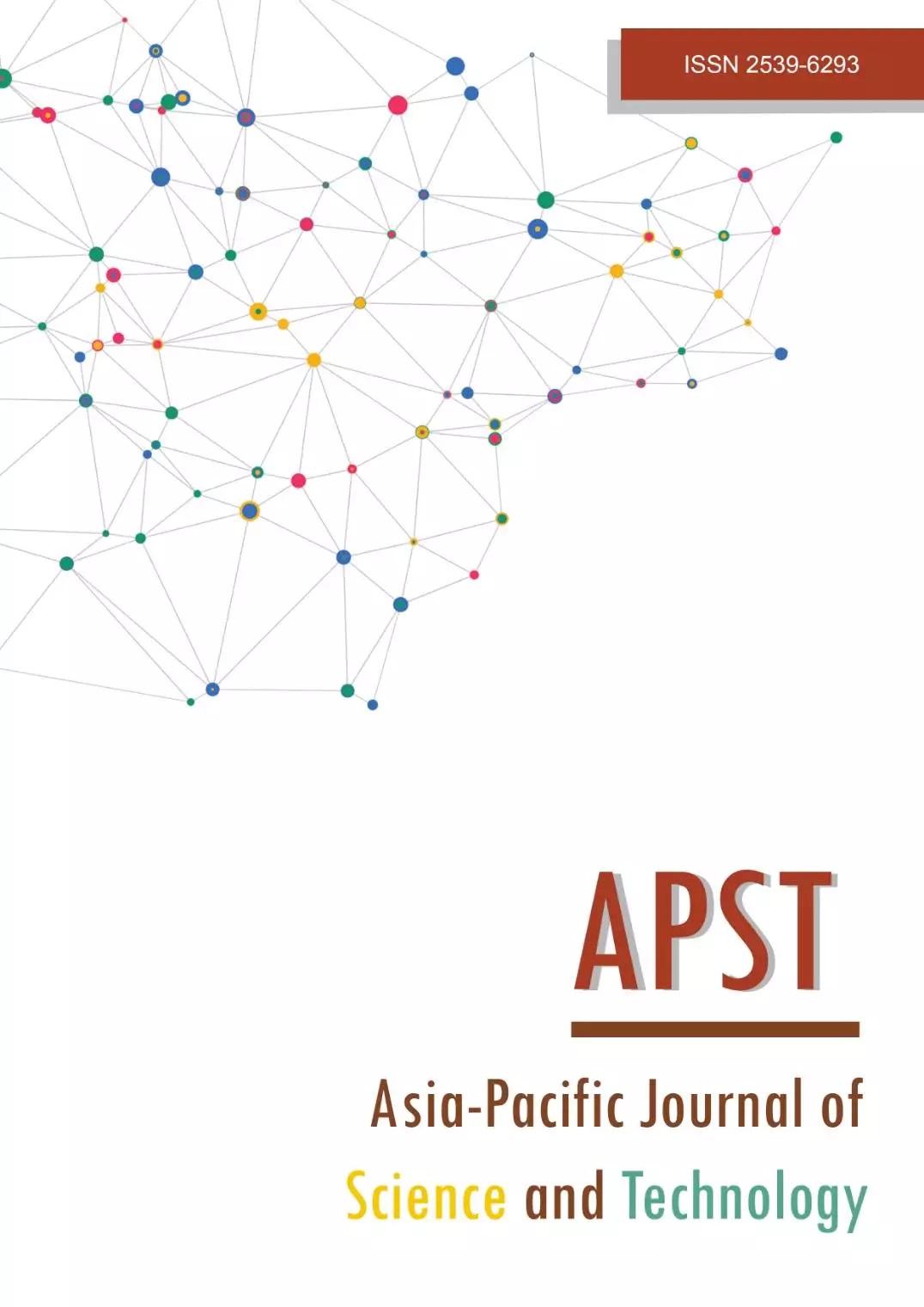Sugar Profile and Recommended Portion Size of Geographical Indication Fruits in Southern Thailand
Main Article Content
Abstract
Fruits are the sources of vitamins, minerals, and phytochemicals, reported a wide range of health potential impacts; however, high natural sugar contents show an association between fruit intake and obesity (a risk factor of non-communicable diseases). This study aimed to determine the sugar profile of well-known geographical indication fruits in southern Thailand and provide recommended portion size of these fruits. Mangosteen, rambutan, longkong, pomelo, and jackfruit, collected from geometry areas, were determined for soluble sugars using direct method LC-MS/MS. Fructose was the most abundant sugar content of fruit samples, ranging between 0.8-30.6 g/100 g (edible part), followed by glucose (ranged between 2.2-23.9 g/100 g) and sucrose (ranged between 0.5-10.4 g/100 g). According to Online Thai Food Composition Database and food exchange, one serving size or one edible portion of each fruit contains 15 g of carbohydrate. The recommended portion size for edible portion is of 3-4 pieces or 85 g of mangosteen, 5-7 pieces or 90 g of rambutan, 2-4 pieces or 177 g of pomelo, 6-9 pieces or 109 g of longkong, and 3-5 pieces or 58 g of jackfruit. These data would be helpful in a health promotion campaign aimed at choosing and limiting the intake of fresh fruit in healthy people to prevent obesity and glycemic control among type 2 diabetes mellitus.
Article Details

This work is licensed under a Creative Commons Attribution-NonCommercial-NoDerivatives 4.0 International License.
References
Liu RH. Health-promoting components of fruits and vegetables in the diet. Adv Nutr. 2013;4(3):384s-392s.
Yoo S, Kim K, Nam H, Lee D. Discovering health benefits of phytochemicals with integrated analysis of the molecular network, chemical properties and ethnopharmacological evidence. Nutrients. 2018;10(8):1042.
FAO/WHO. Promoting fruit and vegetable consumption, https://www.euro.who.int/en/health-topics/disease-prevention/nutrition/activities/technical-support-to-member-states/promoting-fruit-and-vegetable-consumption [accessed 13 January 2022].
Kubola J, Siriamornpun S, Meeso N. Phytochemicals, vitamin C and sugar content of Thai wild fruits. Food Chem. 2011;126(3):972-981.
Zhi C, Ali MM, Zhang J, Shi M, Ma S, Chen F. Effect of paper and aluminum bagging on fruit quality of loquat (Eriobotrya japonica Lindl.). Plants. 2021;10(12):2704.
Teixeira RT, Knorpp C, Glimelius K. Modified sucrose, starch, and ATP levels in two alloplasmic male-sterile lines of B. napus. J Exp Bot. 2005;56(414):1245-1253.
Wee MSM, Henry CJ. Reducing the glycemic impact of carbohydrates on foods and meals: Strategies for the food industry and consumers with special focus on Asia. Compr Rev Food Sci Food Saf. 2020;19(2):670-702.
Sharma SP, Chung HJ, Kim HJ, Hong ST. Paradoxical effects of fruit on obesity. Nutrients. 2016;8(10):663.
Schaefer EJ, Gleason JA, Dansinger ML. Dietary fructose and glucose differentially affect lipid and glucose homeostasis. J Nutr. 2009;139(6):1257s-1262s.
Tappy L. Metabolism of sugars: a window to the regulation of glucose and lipid homeostasis by splanchnic organs. Clin Nutr ESPEN. 2021;40(4):1691-1698.
Stanhope KL, Havel PJ. Fructose consumption: potential mechanisms for its effects to increase visceral adiposity and induce dyslipidemia and insulin resistance. Curr Opin Lipidol. 2008;19(1):16-24.
Huang WQ, Lu Y, Xu M, Huang J, Su YX, Zhang CX. Excessive fruit consumption during the second trimester is associated with increased likelihood of gestational diabetes mellitus: a prospective study. Sci Rep. 2017;7(1):43620.
Department of Intellectual Property. Geographical indication products in each region, https://www.ipthailand.go.th/th/gi-002.html [accessed 5 January 2022].
Shakoor H, Apostolopoulos V, Feehan J, Ali HI, Ismail LC, Al Dhaheri A, et al. Effect of calorie restriction and exercise on type 2 diabetes. Pril. 2021;42(1):109-126.
Institute of Nutrition. Thai food composition database, https://inmu2.mahidol.ac.th/thaifcd/home.php [accessed 10 January 2022].
Pan T, Ali MM, Gong J, She W, Pan D, Guo Z, et al. Fruit physiology and sugar-acid profile of 24 pomelo (Citrus grandis (L.) Osbeck) cultivars grown in subtropical region of China. Agronomy. 2021;11(12):2393.
Akšić MF, Tosti T, Sredojević M, Milivojević J, Meland M, Natić M. Comparison of sugar profile between leaves and fruits of blueberry and strawberry cultivars grown in organic and integrated production system. Plants. 2019;8(7):205.
Wheeler M, Daly A, Evert A, Franz M, Geil P, Holzmeister L, et al. Choose your foods: exchange lists for diabetes, sixth edition, 2008: description and guidelines for use. J Am Diet Assoc. 2008;108:883-888.
Rai MK, Shekhawat N. Recent advances in genetic engineering for improvement of fruit crops. Plant Cell Tiss Organ Cult. 2014;116(1):1-15.
Chareoansiri R, Kongkachuichai R. Sugar profiles and soluble and insoluble dietary fiber contents of fruits in Thailand markets. Int J Food Sci Nutr. 2009;60 Suppl 4:126-139.
Lee PR, Tan RM, Yu B, Curran P, Liu SQ. Sugars, organic acids, and phenolic acids of exotic seasonable tropical fruits. Nutr Food Sci. 2013;43(3):267-276.
Chen J, Vercambre G, Kang S, Bertin N, Gautier H, Génard M. Fruit water content as an indication of sugar metabolism improves simulation of carbohydrate accumulation in tomato fruit. J Exp Bot. 2020;71(16):5010-5026.
McCray M, Swanson S. Soil organic matter impacts on sugarcane production on Florida mineral soils, https://edis.ifas.ufl.edu/publication/AG441 [accessed 19 January 2022].
Kimmons J, Gillespie C, Seymour J, Serdula M, Blanck HM. Fruit and vegetable intake among adolescents and adults in the United States: percentage meeting individualized recommendations. Medscape J Med. 2009;11(1):26.
U.S. Department of Agriculture and U.S. Department of. Health and Human Services. Dietary Guidelines for Americans, 2020-2025. 9th ed. Washington: United States Department of Agriculture; 2020.
Nutrition Division, Department of Health, Ministry of Public Health. Food-based dietary guidelines for Thai: II manual, nutrition flag. Bangkok: Sam Charoen Panich; 2000.
Pem D, Jeewon R. Fruit and vegetable intake: benefits and progress of nutrition education interventions- narrative review article. Iran J Public Health. 2015;44(10):1309-1321.
Wallace TC, Bailey RL, Blumberg JB, Freeman BB, Chen CyO, White CKM, et al. Fruits, vegetables, and health: a comprehensive narrative, umbrella review of the science and recommendations for enhanced public policy to improve intake. Crit Rev Food Sci Nutr. 2020;60(13):2174-2211.


